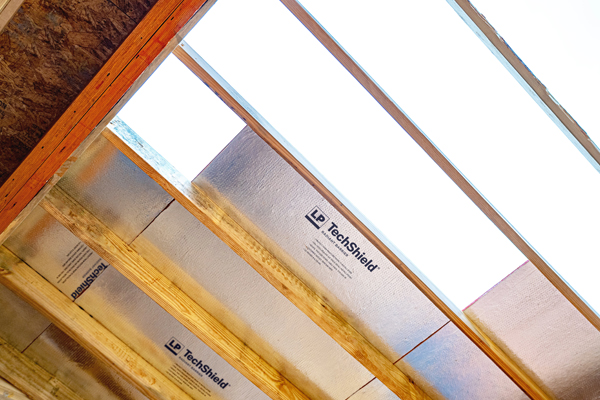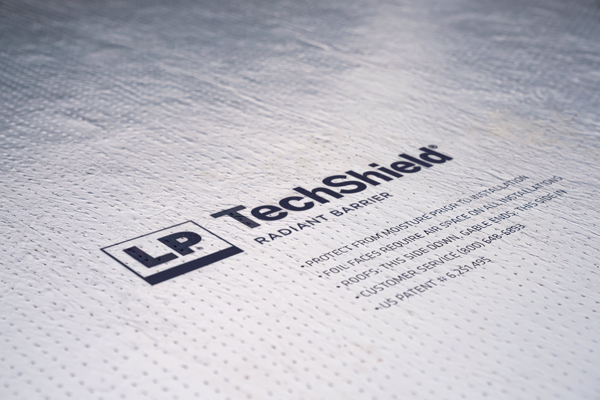Industry Trends6 min
How Energy-Efficient Radiant Barriers Reduce Energy Consumption in Green Building
Green building is a hot topic. As more homeowners expect their homes to run as energy efficiently as possible, many builders are turning to green building standards to improve the overall function of the structure.
Let’s start at the top and see why installing energy-efficient radiant barriers like LP® TechShield® Radiant Barrier may reduce energy consumption and explore other benefits of this green builder favorite.
What is Green Building?
Green building prioritizes the sustainability and performance of a building with a holistic approach that maximizes economy, resiliency, and occupant comfort over the entire life cycle of the home. Green building can include factors like the home’s site selection, design, construction, maintenance, renovation and even deconstruction at the end of its usable life.
Homeowners living in a green-built home can likely expect smaller gas, electric and water bills compared to their neighbors living in traditionally built houses.
Are Codes Changing to Impact Green Building?
Just as builders construct homes to meet or exceed local building codes, some communities across the U.S. are adopting green building practices to improve overall sustainability and clean energy usage. In addition to energy conservation, many of these methods involve water, air, and eco-friendly building materials.
Building codes, however, are a bit different from building practices. Codes are mandated by state and by some local municipalities while practices—like building to LEED (Leadership in Energy and Environmental Design)—are optional programs often using tax breaks as incentives.
Both the Department of Energy and the Environmental Protection Agency (EPA) offer programs to help homeowners save on energy costs. One example is the ENERGY STAR certification program, an EPA green building certification that helps homeowners make good choices by identifying products that can reduce energy consumption.
The ENERGY STAR Rating System and Its Impact on Green Building
To be eligible for an ENERGY STAR certification a product must score 75 or higher on the EPA’s scale of 1–100. Essentially a score of 75 or higher means that a particular product can perform more efficiently than 75% of similar building products across the nation.
Whether you’re building green for mandatory code or to enjoy ENERGY STAR-rated efficiency, topping the house with a radiant barrier is a simple and smart way of building a more energy-efficient home.
How Does a Radiant Barrier Impact Energy Usage?
A radiant barrier can significantly decrease thermal radiation and heat transfer. Energy-efficient radiant barrier sheathing combines a sheathing material, such as OSB, with a reflective material that allows it to reduce heat gain in homes while providing a structural element.
LP TechShield Radiant Barrier is one of the LP Structural Solutions products that can help a building be evaluated for and certified as ENERGY STAR.
“LP TechShield sheathing can block up to 97 percent of the radiant heat from entering into the attic in the first place, helping to keep attic temperatures up to 30 degrees Fahrenheit cooler,” explains Casey Smyth, brand manager for LP Structural Solutions. “This should help curb energy costs while improving the overall efficiency of the HVAC unit.”

Smyth further explains the living areas bordering the attic have an easier time staying cool. “The HVAC doesn’t have to work so hard to keep the entire house cool and comfortable, increasing its overall efficiency,” says Smyth.
Using ENERGY STAR radiant barriers in green construction not only affects the overall energy consumption of the house but can also impact the longevity of the HVAC system. A unit that doesn’t struggle to maintain comfortable temperatures can last longer, which extends the time when that unit hits the landfill, and more energy is consumed to manufacture and ship a replacement unit.
Do Radiant Barriers Qualify for HERS Points?
The Home Energy Rating System or HERS, as it’s commonly called, is the industry standard to measure a home’s energy efficiency. The lower the HERS score, the more energy-efficient a home operates. Some states require a specific HERS score for new construction.
Installing LP TechShield Radiant Barrier may result in lower HERS scores, helping builders meet various energy codes and qualify for local energy efficiency programs.

Looking for more tips on building an energy-efficient house? Read about passive house construction, and read more about energy-efficient solutions here.
Continue Reading
Labor Solutions
5 minChoosing the Right LP® Structural Solutions Product for Your Build
When it comes to building strong, reliable, and high-performing structures, the materials you choose matter. At LP Building Solutions, we understand that every project, whether it’s a single-family home or a multifamily development, requires structural components that meet your needs for strength, durability, and efficiency.
Resiliency Solutions
5 minIntroducing LP® SmartSide® ExpertFinish® Naturals Collection™: Nature-Inspired Beauty Meets Engineered Performance
We’re excited to introduce the LP® SmartSide® ExpertFinish® Naturals Collection™, a bold new addition to our trusted line of engineered wood siding and trim that delivers the warmth and beauty of nature with the advanced protection and performance builders and homeowners expect.
Sustainability Solutions
5 minBuilding a More Sustainable Future with LP Building Solutions
In today’s world, sustainability is no longer just a buzzword, it’s a blueprint for responsible living and smarter building. As the construction industry seeks ways to reduce its environmental footprint, LP Building Solutions is focused on providing innovative building materials for eco-conscious builders to help reshape what it means to build sustainably
News & Stories3 min
History of Partnership with Gary Sinise Foundation
The LP Foundation is a proud partner of the Gary Sinise Foundation, which supports wounded veterans in several ways. You can learn more about the LP Foundation here.